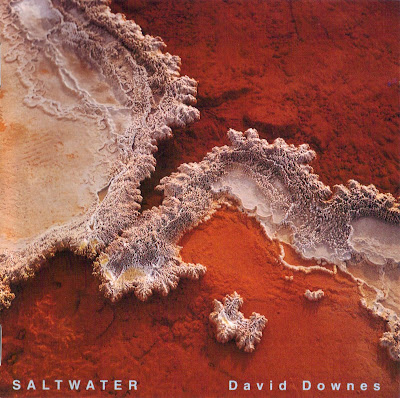The final three CDs in the Jack Body-curated 'Electroacoustic Music by New Zealand Composers' series on CD Manu. All of the entries in this series, barring the Kim Dyett album, have covers taken from photographs by Theo Schoon of geothermal curiosities. I've been a bit cheeky here and designed a replacement cover for the Dyett album from the same series of photographs by Schoon.
David Downes - Saltwater (1988-1992)
 Five of these eight works were composed as soundtracks to dance pieces, and as such contain more aggressively rhythmic content than the other albums in this series. All were
composed when Downes was between the ages of 21-25. ‘Valley Mine’, ‘A Green Piece’ and ‘Saltwater’ use effected field
recordings, white-noise wind and other classic and eighties cutting-edge
synthesis techniques, but pick up some live-sounding percussion and
midi-beats halfway through. If you are hoping for more traditional
electroacoustic composition, skip right ahead to ‘Disquiet’, a
conversation between what feels like improvisatory digital synthesis and
a recording of a housefly buzzing round the room; for me the standout
track on the album.
Five of these eight works were composed as soundtracks to dance pieces, and as such contain more aggressively rhythmic content than the other albums in this series. All were
composed when Downes was between the ages of 21-25. ‘Valley Mine’, ‘A Green Piece’ and ‘Saltwater’ use effected field
recordings, white-noise wind and other classic and eighties cutting-edge
synthesis techniques, but pick up some live-sounding percussion and
midi-beats halfway through. If you are hoping for more traditional
electroacoustic composition, skip right ahead to ‘Disquiet’, a
conversation between what feels like improvisatory digital synthesis and
a recording of a housefly buzzing round the room; for me the standout
track on the album.
Kim Dyett - Wallpaper Music (1982-1986)

The title track is not. at. all. what one would
expect from a piece called ‘Wallpaper Music’, considering that term’s
association with Satie and Eno. Jittery jumpcut sampling and synthesised horns,
squeaks and burps, lead into John Cousins-esque spoken-word sections,
tape-speed effects, shimmering Eventide crystals and quite lovely live guitar
and singing. So maybe it’s wallpapering in the sense of that unintentional
collage which one finds along heavily postered walls and bollards. ‘Song Cycle
Nocturne’ uses the poems of Hone Tuwhare sung and spoken by soloist Rosalund
Solas, with atmospheric electronics often mimicking the birdsong of the kokako,
which sounds like traditional instrumentation mimicking electronic music! Very
beautiful, very NZ. The final piece, ‘Flute Music’, is entirely constructed
from recordings of the composer playing his own, self-carved koauau. Ghostly
whistles, fragments of tunes, with little processing other than looping, stereo
separating, and delay; much more what Satie and Eno had in mind, I believe.
Denis Smalley - Tides (1974-1984)

‘Pentes’ (1974)
is, according to whoever wrote the Denis Smalley article on Wikipedia, one of the classics of electroacoustic
music. But it's no joke. These are serious, complex soundworlds imagined by a rigorous master of the form. Sophisticated timbres are created from instrumental sounds in the isolation of the synthesiser,
and in other sections, snatches of what sound like tapes of orchestral
warm-ups mixed with white noise are slowed to a halt. There are also, as
in many NZ electroacoustic works (like Dyett's), references to native birdsong, and
even (like Downes') to bagpipe music. ‘Tides: Pools and Currents’ is a perfect audio accompaniment to Theo Schoon’s cover photograph of
Rotorua mud pools, or an evocation of autochthonous echinoderms
and cnidarians in their rocky puddles. Its sequel, ‘Tides: Sea Flight’ is
uttered in the same tongue, but describes magnetically shifting immensities, rather than the small and self-contained. ‘Vortex’ jumps around like
Dyett’s ‘Wallpaper’, then coalesces into skirling winds and distant
chimes. Denis Smalley has been, for me, the greatest discovery from this
series. New Zealand born and trained, his award-winning body of work has been entirely electroacoustic, and he deserves more
recognition here both for what he has produced musically, and
academically through his teaching and articles.
 Five of these eight works were composed as soundtrack
Five of these eight works were composed as soundtrack





No comments:
Post a Comment